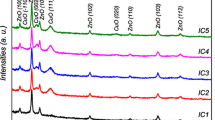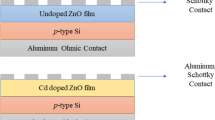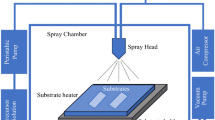Abstract
On the glass substrate, un-doped and different proportions of Yb (1, 2, 3, 4, and 5 wt%) doped CuO thin films were deposited by the ultrasonic spray pyrolysis (USP) method. According to X-ray diffraction (XRD) analysis, the (− 111) plane was the preferred crystallographic orientation for all thin films. It was obtained from atomic force microscopy (AFM) analysis that the surfaces of the produced CuO thin films were not smooth and the roughness increased as the Yb doping ratio increased. Scanning electron microscopy (SEM) analysis reveals that the surfaces of 4 and 5 wt% Yb-doped CuO thin films were porous. The forbidden bandgap values of un-doped and 1, 2, 3, 4, and 5 wt% Yb-doped CuO thin films were calculated by using the Tauc plot. It was observed that 3 wt% Yb-doped CuO thin films with the narrowest bandgap of 1.64 eV. The 3 wt% Yb-doped CuO thin films were deposited on both non-etched and KOH-etched n-type Si by the USP method, and so, p-CuO/n-Si p-n junction diodes were produced. The influence of illumination on several electrical properties of the generated p-n diodes, such as ideality factor (n), zero-bias barrier height (Φbo), and series resistance (Rs), was examined. The p-CuO (un-doped and 3 wt% doped Yb)/n-Si (KOH-etched) diodes exhibited photovoltaic behavior. These diodes show promise for photodiode applications in the optoelectronics industry.










Similar content being viewed by others
Data availability
The data that support the findings of this study are available from the corresponding author, upon reasonable request.
References
C.T. Sah, Characteristics of the metal-oxide-semiconductor transistors. IEEE Trans. Electron. Devices 11, 324–345 (1964)
D. Naveena, T. Logu, R. Dhanabal, K. Sethuraman, A.C. Bose, Comparative study of effective photoabsorber CuO thin films prepared via different precursors using chemical spray pyrolysis for solar cell application. J. Mater. Sci. : Mater. Electron. 30, 561–572 (2019)
N.R. Elezovic, V.R. Radmilovic, N.V. Krstajic, Platinum nanocatalysts on metal oxide based supports for low temperature fuel cell applications. RSV Adv. 6, 6788–6801 (2016)
S. Demirezen, A. Eroğlu, Y. Azizian-Kalandaragh, Ş Altındal, Electric and dielectric parameters in Au/n-Si (MS) capacitors with metal oxide-polymer interlayer as function of frequency and voltage. J. Mater. Sci. : Mater. Electron. 31, 15589–15598 (2020)
J. Zhang, Z. Qin, D. Zeng, C. Xie, Metal-oxide-semiconductor based gas sensors: screening, preparation, and integration. Phys. Chem. Chem. Phys. 19, 6313–6329 (2017)
Q. Zhang, K. Zhang, D. Xu, G. Yang, H. Huang, F. Nie, C. Liu, S. Yang, CuO nanostructures: synthesis, characterization, growth mechanisms, fundamental properties, and applications. Prog Mater. Sci. 60, 208–337 (2014)
A.M. Ahmed, E.M. Abdalla, M. Shaban, Simple and low-cost synthesis of Ba-doped CuO thin films for highly efficient solar generation of hydrogen. J. Phys. Chem. C 124, 22347–22356 (2020)
M.R. Waikar, A.A. Shaikh, R.G. Sonkawade, The supercapacitive performance of woollen-like structure of CuO thin films prepared by the chemical method. Vacuum 161, 168–175 (2019)
S. Baturay, A. Tombak, D. Kaya, Y.S. Ocak, M. Tokus, M. Aydemir, T. Kilicoglu, Modification of electrical and optical properties of CuO thin films by Ni doping. J. Sol-Gel Sci. Technol. 78, 422–429 (2016)
K. Santra, C.K. Sarkar, M.K. Mukherjee, B. Ghosh, Copper oxide thin films grown by plasma evaporation method. Thin Solid Films 213, 226–229 (1992)
D. Naveena, T. Logu, K. Sethuraman, A.C. Bose, Significant enhancement of photo-physicochemical properties of Yb doped copper oxide thin films for efficient solid-state solar cell. J. Alloys Compd. 795, 187–196 (2019)
I. Singh, G. Kaur, R.K. Bedi, CTAB assisted growth and characterization of nanocrystalline CuO films by ultrasonic spray pyrolysis technique. Appl. Surf. Sci. 257, 9546–9554 (2011)
S.C. Tsai, Y.L. Song, C.S. Tsai, C.C. Yang, W.Y. Chiu, H.M. Lin, Ultrasonic spray pyrolysis for nanoparticles synthesis. J. Mater. Sci. 39, 3647–3657 (2004)
D. Bayuwati, Comparison of SnO2/Si-n thin films deposited by pneumatic spray pyrolysis technique with that deposited by ultrasonic spray pyrolysis technique. Indones J. Mater. Chem. 43, 241–245 (2008)
M.L. Zeggar, L. Chabane, M.S. Aida, N. Attaf, N.Zebbar, solution flow rate influence on properties of copper oxide thin films deposited by ultrasonic spray pyrolysis. Mater. Sci. Semicond. Process. 30, 645–650 (2015)
H.Z. Asl, S.M. Rozati, Spray deposited nanostructured CuO thin films: influence of substrate temperature and annealing process. Mater. Res. 21, e20170754 (2018)
P. Venkateswari, P. Thirunavukkarasu, M. Ramamurthy, M. Balaji, J. Chandrasekaran, Optimization and characterization of CuO thin films for p-n junction diode application by JNSP technique. Optik 140, 476–484 (2017)
D.P. Dubal, G.S. Gund, C.D. Lokhande, R. Holze, CuO cauliflowers for supercapacitor application: novel potentiodynamic deposition. Mater. Res. Bull. 48, 923–928 (2013)
W. Yin, J. Yang, K. Zhao, A. Cui, J. Zhou, W. Tian, W. Li, Z. Hu, J. Chu, High responsivity and external quantum efficiency photodetectors based on solution-processed Ni-doped CuO films. ACS Appl. Mater. Interfaces 12, 11797–11805 (2020)
R.D. Shannon, Revised effective ionic radii and systematic studies of interatomic distances in halides and chalcogenides. Acta Cryst. 32, 751–767 (1976)
D.A. Aldemir, Structural, morphological and optical properties of Yb2Cu2O5 thin films. J. Mater. Sci. 30, 19457–19462 (2019)
Y. Zhang, Electronegativities of elements in valence states and their applications. 1. Electronegativities of elements in valence states. Inorg. Chem. 21, 3886–3889 (1982)
H. Angermann, W. Henrion, M. Rebien, A. Röseler, Wet-chemical preparation and spectroscopic characterization of Si interfaces. Appl. Surf. Sci. 235, 322–339 (2004)
J. Naktiyok, A.K. Özer, Synthesis of copper oxide (CuO) from thermal decomposition of copper acetate monohydrate (cu(CH3COO)2.H2O). OHU J. Eng. Sci. 8, 1292–1298 (2019)
V. Saravan, P. Shankar, G.K. Mani, J.B.B. Rayappan, Growth and characterization of spray pyrolysis deposited copper oxide thin films: influence of substrate and annealing temperatures. J. Anal. Appl. Pyrolysis 111, 272–277 (2015)
B.D. Cullity, Elements of X-ray Diffraction (Addison-Wesley Publishing, Boston, 1956)
L. Debbichi, M.C. Marco de Lucas, J.F. Pierson, P. Krüger, Vibrational properties of CuO and Cu4O3 from first-principles calculations, and Raman and infrared spectroscopy. J. Phys. Chem. C 116, 10232–10237 (2012)
K. Ungeheuer, K.W. Marszalek, M. Mitura-Nowak, M. Perzanowski, P. Jelen, M. Marszalek, M. Sitarz, Influence of Cr ion implantation on physical properties of CuO thin films. Int. J. Mol. Sci. 23, 4541 (2022)
Z. Shaghaghi, A.R. Amani-Ghadim, M. Seraji, Structural properties and photocatalytic degradation efficiency of CuO and erbium doped CuO nanostructures prepared by thermal decomposition of some Cu-salophen type complexes as precursors. Mater. Chem. Phys. 243, 122635 (2020)
J. Tauc, R. Grigorovici, A. Vancu, Optical properties and electronic structure of amorphous germanium. Phys. Status Solidi B 15, 627–637 (1966)
M.K. Basher, M.K. Hossain, M.J. Uddin, M.A.R. Akand, K.M. Shorowordi, Effect of pyramidal texturization on the optical surface reflectance of monocrystalline photovoltaic silicon wafers. Optik 172, 801–811 (2018)
E.H. Rhoderick, R.H. Williams, Metal-semiconductor contacts, 2nd edn. (Clarendon, Oxford, 1988)
D.K. Schroder, Semiconductor material and device characterization, 3rd edn. (Wiley, New Jersey, 2006)
H.E. Lapa, A. Kökce, D.A. Aldemir, A.F. Özdemir, The response of high barrier Schottky diodes to light illumination. J. Mater. Sci. 32, 4448–4456 (2021)
J. Allison, Electronic engineering semiconductors and devices, 2nd edn. (McGraw-Hill, London, 1990)
Funding
The authors have not disclosed any funding.
Author information
Authors and Affiliations
Contributions
HEL: studies conceptualization, writing (original draft) the manuscript, the experimental process, and the data collection and analysis.
Corresponding author
Ethics declarations
Conflict of interest
The author declares that I have no known competing financial interests or personal relationships that could have appeared to influence the work reported in this paper.
Additional information
Publisher’s Note
Springer Nature remains neutral with regard to jurisdictional claims in published maps and institutional affiliations.
Rights and permissions
Springer Nature or its licensor (e.g. a society or other partner) holds exclusive rights to this article under a publishing agreement with the author(s) or other rightsholder(s); author self-archiving of the accepted manuscript version of this article is solely governed by the terms of such publishing agreement and applicable law.
About this article
Cite this article
Lapa, H.E. The effect of illumination on p-n junction diodes based on Yb-doped CuO thin films produced by ultrasonic spray pyrolysis method. J Mater Sci: Mater Electron 34, 425 (2023). https://doi.org/10.1007/s10854-023-09866-x
Received:
Accepted:
Published:
DOI: https://doi.org/10.1007/s10854-023-09866-x




